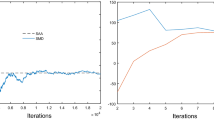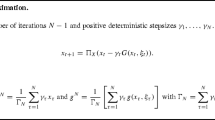Abstract
Stochastic programs are usually hard to solve when applied to real-world problems; a common approach is to consider the simpler deterministic program in which random parameters are replaced by their expected values, with a loss in terms of quality of the solution. The Value of the Stochastic Solution—VSS—is normally used to measure the importance of using a stochastic model. But what if VSS is large, or expected to be large, but we cannot solve the relevant stochastic program? Shall we just give up? In this paper we investigate very simple methods for studying structural similarities and differences between the stochastic solution and its deterministic counterpart. The aim of the methods is to find out, even when VSS is large, if the deterministic solution carries useful information for the stochastic case. It turns out that a large VSS does not necessarily imply that the deterministic solution is useless for the stochastic setting. Measures of the structure and upgradeability of the deterministic solution such as the loss using the skeleton solution and the loss of upgrading the deterministic solution will be introduced and basic inequalities in relation to the standard VSS are presented and tested on different cases.
Similar content being viewed by others
References
Ariyawansa, K. A., & Zhu, Y. (2010, under review). A preliminary set of applications leading to stochastic semidefinite programs and chance-constrained semidefinite programs. Mathematical and Computer Modeling. Technical Report No. 8, Department of Mathematics, Washington State University.
Birge, J. R. (1982). The value of the stochastic solution in stochastic linear programs with fixed recourse. Mathematical Programming, 24, 314–325.
Birge, J. R., & Louveaux, F. (1997). Introduction to stochastic programming. New York: Springer.
Garver, L. L. (1963). Power generation scheduling by integer programming-Development of Theory. IEEE Transactions on Power Apparatus and Systems, 81, 730–735.
Higle, J. L., & Wallace, S. W. (2003). Sensitivity analysis and uncertainty in linear programming. Interfaces INFORMS, 33(4), 53–60.
Kall, P., & Wallace, S. W. (1994). Stochastic programming. Chichester: Wiley.
Ko, Y.-B., & Vaidya, N. H. (2000). Location-Aided Routing (LAR) in mobile ad hoc networks. Wireless Network, 6(4), 307–321.
Maggioni, F., Potra, F., Bertocchi, M., & Allevi, E. (2009). Stochastic second-order cone programming in mobile ad hoc networks. Journal of Optimization, Theory and Applications, 143, 309–328.
Maggioni, F., Wallace, S. W., Bertocchi, M., & Allevi, E. (2010). Sensitivity analysis in stochastic second-order cone programming for mobile ad hoc networks. Procedia Social and Behavioral Sciences, 2, 7704–7705.
Maggioni, F., Kaut, M., & Bertazzi, L. (2009). Stochastic optimization models for a single-sink transportation problem. Computational Management Science, 6, 251–267.
Prékopa, A. (1995). Stochastic programming. Dordrecht: Kluwer Academic.
Wallace, S. W. (2000). Decision making under uncertainty: is sensitivity analysis of any use? Operation Research, 48(1), 20–25.
Williams, H. P. (1985). Model building in mathematical programming. New York: Wiley. ISBN 0-471-99788-9.
Thapalia, B. K., Wallace, S. W., Kaut, M., & Crainic, T. G. (2010, to appear). Single source single-commodity stochastic network design. In Stochastic single-commodity network design; Biju K. Thapalia, Molde University College, PhD thesis 2010:2, pp. 33–55.
Author information
Authors and Affiliations
Corresponding author
Rights and permissions
About this article
Cite this article
Maggioni, F., Wallace, S.W. Analyzing the quality of the expected value solution in stochastic programming. Ann Oper Res 200, 37–54 (2012). https://doi.org/10.1007/s10479-010-0807-x
Published:
Issue Date:
DOI: https://doi.org/10.1007/s10479-010-0807-x




